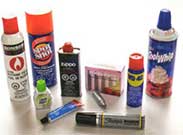|
|
 |
|
The views expressed on this page are soley
those of the author and do not
necessarily represent the views of County
News Online
|
 |
Start Talking!
Know! To
Prevent Huffing, Sniffing and Bagging
5/17/2017
What do nail polish, deodorant spray, permanent markers and correction
fluid all have in common? They are all items we would expect to find in
our children’s bedroom or study area, right? They certainly are not
products that would signal a red flag or cause us to question their use
- nor should they necessarily. However, each of these items are also
common “inhalants” with the potential to harm.
According to the 2015 Monitoring the Future Study, nearly one in 10
American children give inhalants a try by the time they reach eighth
grade. Some refer to inhalants as “kids’ drugs,” because they are the
only class of substance abused more by children and younger adolescents
than by older teens, with the majority of users being 11 to 14 years
old. But don’t let this fool you into believing inhalants are innocent
kid’s play - they are not.
What exactly are inhalants and why are they so popular among younger
children?
Inhalants are chemical vapors (gases or fumes) that are breathed in for
the purpose of getting high. The slang terms are huffing (inhaling
chemicals through the mouth), sniffing (snorting fumes through the
nose), and bagging (spraying chemicals into a bag and then breathing it
in). These chemicals are found in everyday products like cooking spray,
nail polish remover and hair spray, which is one of the reasons
inhalants are popular among younger children. These products are
readily accessible at home and school; they are legal products that can
be purchased by children without drawing attention; they are
inexpensive; they are easy to conceal; they don’t require
paraphernalia; and youth do not generally realize the dangers inhalants
pose.
The truth is inhalants are dangerous. According to the National
Institute on Drug Abuse (NIDA), inhalants negatively impact the brain
and can cause children to experience difficulties with learning,
remembering, problem-solving and paying attention – negatively
impacting their school performance as well. In addition, inhalants
effect the circulatory and respiratory systems, sometimes triggering
severe headaches, irregular heart rhythm, decreased rate of breathing
and loss of consciousness.
Furthermore, inhalants can be deadly. Far too often, fatalities occur
from sudden sniffing death, suffocation and choking, which can happen
even on first use. And, as with any drug abuse, accidents can occur due
to inhalant intoxication, resulting in serious injury or death.
How can you protect your children from inhalant use?
Storing cleaning products and such out of reach of young children is
good prevention practice. However, there are more than 1,400 household
and commercial products that contain chemicals used as inhalants,
therefore it is unrealistic to think you can prevent this type of abuse
among older children by hiding or keeping track of every chemical
product in your home.
What you are encouraged to do, instead, is include this important topic
in your regular and ongoing conversations with your children.
Statistics show that a child is 50 percent less likely to try an
inhalant if an adult has spoken to them about the dangers of inhalant
abuse – so Start Talking! today!
Click here for more information and additional resources on inhalants.
Learn how to get the drug prevention conversation started at
StartTalking.Ohio.Gov.
|
|
|
|

